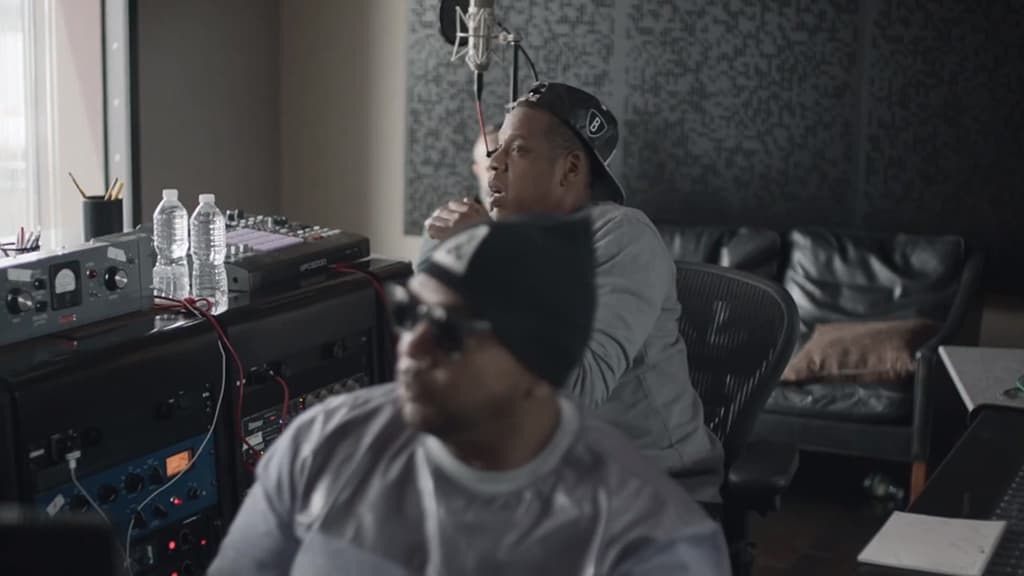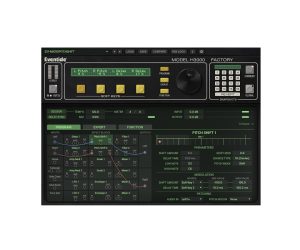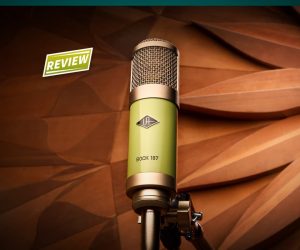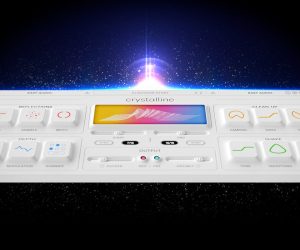
Search For The Holy Grail
Jay Z sold a million copies of Magna Carter Holy Grail before it was even released to the public. But has he struck on that sacred balance of creativity and commerce?
Watch: Open Letter from
Jay Z’s Magna Carter Holy Grail
Story: Paul Tingen
The atmosphere was charged when Demacio ‘Demo’ Castellon arrived at the Penthouse Room, Jungle City studio in New York. It was the evening of April 10, 2013, and a wild thunderstorm was raging outside, adding a whiff of the surreal to a tumultuous day. Jay Z and Beyoncé had been copping criticism from US conservatives for celebrating their fifth wedding anniversary in Cuba a week earlier (the embargoed Communist country is a no-go zone for American tourism). It was a storm in a teacup, really — the couple had travelled under the licence of the Sir John Soane Museum Foundation and their trip satisfied all the requirements — but their celebrity and Obama supporter status had sufficiently rankled the Republican house to balloon the controversy into a US-wide debate. It all set the scene for what Castellon described as one of the most memorable moments of his career.
“There had been quite a bit of slandering going on in the media of Jay Z and his wife,” said Castellon. “So Tim[baland], Swizz [Beatz] and Jay had decided they wanted to record a new song about the situation and put it out that night! They began conceptualising and creating a beat, and Jay was listening to it and coming up with ideas. After a few minutes he went in and spat out the first verse. When we heard that first line, I done turned Havana to Atlanta/ Guayabera shirts and bandanas, we thought, ‘This is going to be incredible!’”
The rest of the lyrics pulled no punches:
Politicians never did shit for me
Except lie to me, distort history
Wanna give me jail time and a fine
Fine, let me commit a real crime
This line in particular had Obama answering questions all week:
Boy from the hood but got White House clearance
Castellon: “The windows of the studio were covered, but Jay suggested we open everything up. With the thunderstorm going on outside, whenever lightning struck the room would light up. There was a lot of energy.
“While we were working, more and more people came in until there were about 20 people in the room. Entourage doesn’t normally hang out when a track is written, you could tell they noticed something special was going on. At 10:30pm I was given a deadline for midnight, but the session went on until 5:30am. As the night went on, Beyoncé, Trey Songz, Rita Ora, and Just Blaze also came in and we were just vibing — lightning was flashing, and everything was flowing. We must have played that song 150 times! Just before 6am I was asked to email the label the finished track, and it was released online at 6:15am. By 8am Open Letter was mentioned on CNN, and at 9am a White House press secretary was talking about it. I was sitting there going, ‘what just happened?’”


OPEN DOOR POLICY
The events surrounding the making, release of, and the reactions to Open Letter are a perfect illustration of the lightning speed of today’s digital and online world. The recording also marked, in Castellon’s view, the true genesis of Jay Z’s 12th studio album Magna Carta Holy Grail, “because that session was so epic and memorable”. Work on the album continued at Alicia Keys’ and Swizz Beatz’s Jungle City until the middle of June, with a large number of producers, engineers and mixers involved. In addition to Timbaland, Swizz Beatz and Castellon, the studio also saw producers like No ID, Jerome ‘J-Roc’ Harmon, The-Dream, Mike Dean and Pharrell Williams in action, as well as engineers Chris Godbey, Ramon Rivas, Matt Weber, and mixer Ken ‘Duro’ Ifill. Castellon and Godbey, Timbaland’s regular engineer, both played central roles in the making of Magna Carta Holy Grail, with Castellon co-engineering 11 of the album’s 16 songs and mixing eight. But he stressed that work on Magna Carta Holy Grail was incredibly collaborative. Even Rick Rubin stopped by to have a listen.
“I would say that Chris [Godbey] and I recorded the majority of the Jay Z record, with Chris being there from the beginning, and several mixers, like Jaycen Joshua, Mike Dean and Duro, also involved,” said Castellon. “Sometimes when you have lots of engineers working on one album, the sonics don’t necessarily sit together well, but in this case we all worked together to make the album sound consistent. We were working in two rooms at Jungle City: the official Penthouse Room, with SSL Duality and EMI TG12345 MkIII consoles, and Alicia and Swizz’s private penthouse studio adjacent to that, which has more or less the same gear. We were all working in the same vicinity, with Jay having the oversight. We loved working on this album, which has a great theme, and there were really no egos. As you can see in the Samsung commercial about the making of the album, everyone was creative — commenting and collaborating on everything.”
Jay Z expounded on the theme in that same commercial, describing it as the “duality of how do you navigate through this whole thing, through success, through failures, through all this and remain yourself?” It’s an especially relevant question, given the delivery method. That same Samsung commercial was part of a deal which made the first million download copies of Magna Carta Holy Grail available free to Samsung smartphone customers on July 4, well before the regular retail release on July 7. Samsung footed the $5m album download bill as part of a broader deal with Jay’s label, Roc Nation, worth a reported $20m. It’s an impressive coup in the face of the technological and financial realities of selling music in 2013. But did he manage to negotiate the other side of this duality as effectively, and separate the ‘church and state’ of creativity and commerce?

Castellon: “The way the Holy Grail session is laid out is a blueprint for my session layout when I work with Timbaland. Drums and rhythms are part of his signature sound, so he really likes working on them, and when we mix he’s usually on the left side of the console, where the drums are, and I’ll be on the right. We’ll work like that for a bit, and then we’ll switch. You can also see the colour coding in the session, with the drums at the top, in red [34 audio tracks], then No ID’s section, which consists of background noises and yeahs and so on in blue [five audio tracks], then the music, including two piano tracks [five tracks] in red again (they were all programmed, there were no live musicians in this session), then five tracks of Timbaland ‘Yas’ and effects in blue, some samples in red (they were orchestral hits and so on that we made, and weren’t really samples), and below that are the vocals, starting with 16 tracks of Justin Timberlake’s hook backing vocals, and then Timberlake’s lead vocals and Jay Z’s verse rapping. Right at the bottom are several aux effect tracks.”
ATTITUDE ADJUSTMENT
Just like the Samsung deal typified the ‘anything goes’ nature of modern music dealmaking (or, at least, Jay Z’s ability to flip between rapper and entrepreneur with increasing ease), the record-making process was also based on present-day principles. According to Castellon, even the camaraderie during the making of the album was a sign of the times, as was the fact he worked more in-the-box on Magna Carta Holy Grail than ever before. “I think even 10 years ago attitudes were different,” he said. “People have come to the realisation that they are really fortunate to do the things they do, especially when you look at the terrible unemployment around the world. It really is a blessing to work with people that inspire you, to have the opportunity to make records and do what you love doing, and get paid for it. Also, when you’re a positive person, artistic and creative, you’ll end up working with similar people, and won’t be involved with people with big egos and bad energies. Regarding the in-the-box situation, this is an ongoing process for me. Four years ago I decided I wanted to evolve and focus more on the in-the-box aspect and get better at it. It was a matter of curiosity and wanting to add a new facet to my technique, but decreasing budgets also played a part. I have a small personal studio in Florida Keys with an SSL AWS948 and a ProTools system, which I use when I want to pull up a mix or lay down an idea. And while I still tend to use the console for compression and EQ, I am using more plug-ins than ever before.”
At the same time as Castellon was embracing more modern processes, the idea was to “make the record sound a bit like old hip-hop records, which didn’t have a lot of stuff going on. We wanted it to be more about feel than anything else. Chris does really amazing stuff in ProTools, and we collaborated a lot on creating tonal effects that form part of the sounds making up the music. With two of the songs in particular, F.U.T.W. and Heaven, there was not a lot going on, and we really went for this grimy, old hip-hop sound. We tried overdriving the Duality at Jungle City, which got a little too distorted, and played around with bottom frequencies, and made things a little duller, to make it sound like vinyl records. We did a lot of things like that.
“Although we did a lot in-the-box during this project, Timbaland loves analogue, and all the music was recorded going through the EMI TG12345 console. He will rarely go straight into ProTools from his laptop, Open Labs Miko, Ensoniq ASR10, or whatever device he’s using. There will usually be some analogue gear in the signal chain. Jay’s vocal chain is always the same: a Neumann U87 going through an Avalon 737. All his engineers try to use that chain, because sometimes he wants to change a word or a line and it’s important to have consistency. On a couple of songs the U87 went into a Neve 1073 or 1081 and then a TubeTech CL1B. We used the latter chain on Open Letter.
MIX BEGINNINGS
When the time came for Castellon to mix single Holy Grail, he found the payoff of working in-the-box to be a lot more than the ability to recall sessions easily. “Advances in working-in-the-box techniques mean records really sound how they’re supposed to sound very early on,” he remarked. “The basic concepts and ideas are there very quickly. Back in the days of tape, engineers took their time to get all the sounds right, so by the time it went to mixing it was just a matter of level adjustments. We’re getting back to that, because the rough mixes nowadays are pretty much what the record is going to be. In hip-hop records you want some more bottom end and feel, and perhaps you adjust the vocal level a bit. In some respects the final mix is a little bit like a mastering job, where you are just trying to get the rough mix to sound louder, and make some tonal adjustments. So the jobs have changed a bit. I was involved in rough mixing Holy Grail, doing loads of rides and always adjusting drum levels. Rough mixes would vary greatly for each of the songs and at some stage Tim and others will decide what rough mix they liked listening to, and that rough mix will be the starting point for the final mix.”
Even though Castellon was involved in the recording process, when it came time to mix, getting the sessions in perfect nick was still the first step of his process. Castellon: “A large part of mixing is organisation, and I spent quite a bit of time organising the sessions, making sure all edits are clean, labelling things, cleaning out pops or dead space in the live tracks, and so on. As I mentioned, most of the music was recorded via the EMI console, so there was some noise on there, nothing crazy, but I cleaned that up. Speed of recording is very important, but it means you need to go back later on and make sure everything went down okay, because a cable may have gone bad, or a phase issue, or a mic went out. You want to identify those things early.
“The console at Jungle City is a 48-channel SSL Duality, and I spread the session out over as many channels as possible. I kept the different piano and vocal tracks separate, but I combined things like all 808s, and all kicks, and some of the snares, and all the hi-hats. Some of the blends were just right, so I didn’t mess with them. I really enjoyed using the Duality. The main reason for using it was the summing, which gave me a little bit more of the width that I was looking for. It actually also added more height, which I hadn’t expected. The mix sounded taller even without using any of the EQs.
It was released online at 6:15am. By 8am Open Letter was mentioned on CNN, and at 9am a White House press secretary was talking about it


Jay Z’s main vocal chain is spread with Waves’ Mid Side Center and doubled for more width. It’s also compressed and distorted with Soundtoys’ Decapitator for extra harmonics.

Castellon put Justin Timberlake’s vocal through two stages of compression as well as boosting the top end after deessing any unwanted peaks. The vocal was Autotuned, but Castellon said it just helps the vocal “cut through the track better.” It then goes through seven of eight effects busses. See ‘Bus Route’ for more.
HOLY GRAIL
“Holy Grail was the first song I mixed for the album, and it was also the first song I mixed at Jungle City, so I wanted to make sure that things would translate right. We used the Barefoot Micromain27 speakers, which are my favourites, and I spent a good day getting used to the console and the room. The mix of Holy Grail would set the tone for the album, so I took my time with it. The next thing Jay came in and said, ‘Oh man, this is dope, though perhaps make the vocal a bit louder.’ I didn’t use a lot of compression in this mix, because it didn’t need it. Instead it was mostly EQ to make sure everything had space and that the low end worked. Holy Grail was on the desk for a couple of days, until Tim came in and approved it and we printed it.
“How I actually start a mix depends on the song, but what I’ve been doing recently is go to the section of the song that has the most music parts in it, and loop that, and I’ll get a quick overall balance to make sure everything sits right. This obviously was irrelevant to the beginning section of Holy Grail, which is one and a half minutes of mainly Justin Timberlake singing with a piano, with no low end or drums at all. I always thought that we’d need to do a radio edit of the song because I wasn’t sure whether keeping out the drums for so long was going to work, but the more I listened to it, the more I thought the intro was something really fresh. The song starts off so pretty and poppish and emotional, and then when the first verse drops and the drums kick in, it has a very big impact. I treated the intro like a separate song, and for the rest of the song the drums were pretty consistent, so I treated that as one section as well, and when I brought the drums and Justin and the piano together later in the song, it worked surprisingly well.
“The song has some dramatic shifts, and keeping the flow going was a challenge. But the performances were so good that it made my job easy. Justin’s performance is really captivating. He sounds quite different from the way he normally sounds, and I wanted to keep and emphasise that, and give him a space of his own, so he almost sounds like a different artist. When I mixed his voice I envisioned him sitting in a big theatre singing to a small crowd, so you had the sound of the entire space, but you’re sitting in the front row and he’s singing right at you. I did this using delays and some reverb. Justin is so musical and he really cares about the production. He was working next door at Jungle City on his own album, and he would often come over and sit with us for the mixes for Jay Z’s album, giving suggestions regarding his vocals, but also for songs that he didn’t appear on!”

Demacio ‘Demo’ Castellon studied engineering at Full Sail University in Florida and after graduating worked his way up from sweeping floors to assistant engineer at the Hit Factory in Miami. He then became Missy Elliott’s engineer before joining Timbaland’s team in 2002 where he was tutored by engineer/mixer Jimmy Douglass. Castellon now works for a variety of clients, including his wife Nelly Furtado.

BUS ROUTE
Width and depth are crucial to pop mixes. Along with Justin Timberlake’s 16 backing vocal tracks, his main vocal is sent to seven effects buses. check out the breakdown above.
VOCALS A TREAT
The screen shots for the session of Holy Grail show that, by far, the most plug-ins were used on vocals. Apparently the drums and music didn’t need much work during the final mix. Castellon gave the lowdown: “I used SSL Duality EQ and some compression on much of the drums and music, and had Lo-fi and McDSP Filterbank E6 on the 808 and the kick. I also had a little bit of ReVibe on one of the snares, because we noticed that the snare was drowning out the vocal a little bit, and the reverb helped soften the snare sound. The hi-hat also had some Filterbank, as did some other percussion elements. I also used some more Lo-fi, E6, Renaissance EQ and McDSP compression on them. The piano had an E6 as well and again the ReVibe, plus some desk compression and an outboard Bricasti M7 reverb I had never used before, but had some really cool algorithms. I used a plate and a small setting, and it was the most important effect I used on the music. Timbaland didn’t want too much depth in the music, he wanted it relatively straight, to make sure the vocals had the depth and the space. I printed the digital piano effect below the piano track.
“There are many vocal tracks, and during the mix I was really doing my best to enhance the performances. Once the music was where it needed to be, I really needed to make sure the vocals were able to cut through the track so you can hear every syllable. That required quite a bit of volume riding in the automation and compression. Some of the low backing vocals sounded a bit muddy, so that meant either adding less of them, rolling off a bit below 200Hz, or adding some low mids. It was often a matter of trial and error.
“The 16 tracks with Justin’s hook backing vocals go to a group track, HK Chain, on which I have the McDSP Filterbank, Waves Renaissance Compressor, and four of the aux effects in the session — Heavenly, Verb, Med Delay and ¼ Delay. The 16 tracks all have Auto-Tune on them, but it’s only a touch, because Justin is a very good singer, and in his case the reason is that a tiny bit of Auto-Tune helps the vocal cut through the track better. The Heavenly effect was a Waves Renaissance De-Esser over which we put a Sound Toys SoundBlender, aka Pitch Blender. Together they created a… heavenly sound! It helped with the texture of Justin’s vocal, and we also used some on the two ‘The Dream’ vocal tracks, which appear only during the Nirvana sample. The Verb comes from an RVerb, the Medium Delay from a Digirack Mod Delay II, and the ¼ Delay from a SoundToys EchoBoy which then went through a Waves MetaFlanger.
“Further down the session are Justin’s main lead vocals, which are marked as ‘tuned’, but once again, very gentle. When we mark a vocal ‘tuned’ it tends to mean that all the comps and edits are done and that it’s the final vocal. Justin’s lead vocals have similar effects on them as his backing vocals — ie. the FilterBank, RCompressor, a De-esser and another RCompressor on the inserts. They’re also being sent to effects like Heavenly, Verb, Med Delay, ¼ Delay, ½ Delay (which comes from the Mod Delay II and is then sent to the Waves GTR Stomp) and an EchoBoy Doubler. The de-esser in this case is the McDSP DE555, which was put on the session by Chris. There’s a Quad send, but it wasn’t used. There also are some JT Pre tracks, which occurred during the Nirvana sample, and one has the Decapitator, which is an effect that Martin Solveig introduced to me when we were working with Madonna. It’s great for adding different levels of distortion. Finally, Jay’s vocals had the RCompressor, the FilterBank, a Med Delay and a ¼ Delay. He also appears during the Nirvana sample, when I also treated his vocals with the Decapitator, as well as a Waves Doubler and a Waves Center.
“The resolution of the session was 24-bit/44.1k, and I printed the mix back into the session. I actually had nothing on the master bus. We did have some limiting on the rough mixes, and once we had a setting we liked we had that on everything, and I also kept that on the stems. I also printed everything as stems, because the artists use them when they play live. Chris and I were trying different plug-ins all the time, but to my ears they still all sound pretty much the same. It’s more about whether you like the functions they have and the way they look. Because they sound so similar you don’t need one million plug-ins, you just need 10 that you know really well, and will give you the same result. In general, I’d say that using outboard still allows you to create unique sounds, whereas plug-ins are more surgical. But I’m still learning and figuring things out. People say to me: ‘what are you talking about? You’ve been doing this for 15 years!’ But my answer is that we are all still growing and learning, and as long as you are doing that and are still interested in new things and are still inspired to improve your craft, you’re on the right path.”
















RESPONSES